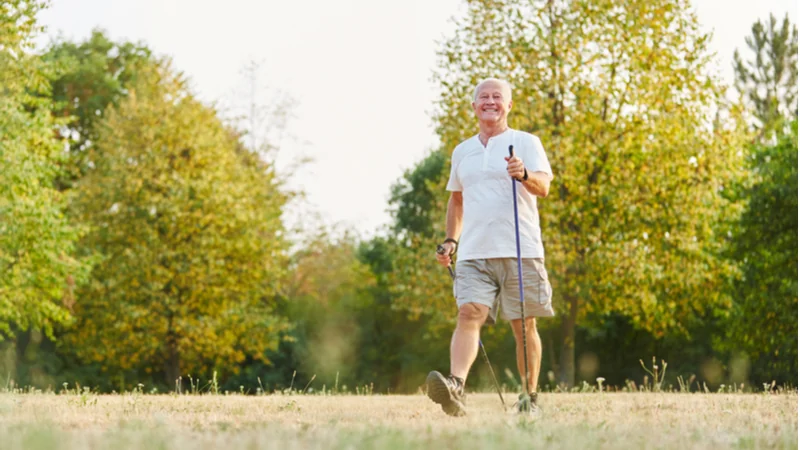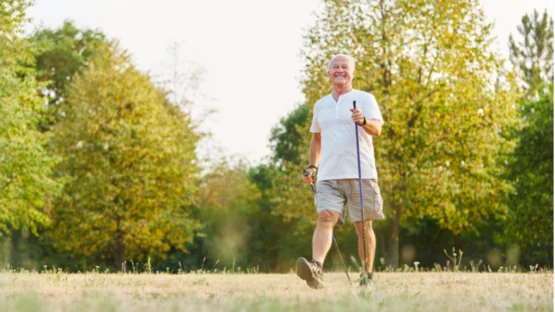Publishing in Nature Communications, Dr. Tom Yate, Dr. Neliesh J. Samani, and colleagues used data from approximately 400,000 people in the UK Biobank in order to examine the relationship between walking pace and telomere length.

Read More
Previous evidence suggests that increased physical activity and cardiorespiratory fitness is associated with longer telomere length [1,2]. However, previous research linking lifestyle factors and telomere length are small and observational. The authors of this study sought to determine the association between self-reported walking pace and the telomere length of specific white blood cells known as leukocytes.
Study participants
The participants were an average of 56.5 years old, with a mean BMI of 27.2. 54% of the participants were female, and 95% of the participants were white. Descriptive statistical differences were seen between the slow, average, and brisk walkers. When compared to the slow walkers, the brisk walkers were slightly younger, more likely to have never smoked, were less likely to have mobility limitations and were less likely to be on cholesterol and/or blood pressure medication.
Slow walkers also reported engaging in less physical activity, had higher rates of obesity, and were more likely to live in a deprived living situation as measured by a multiple deprivation index when compared to the average and brisk walking groups. Accelerometer data was mostly comparable between the walking pace groups.
Walking pace was associated with telomere length
Compared to the slow walkers, the average and brisk walkers had significantly longer telomere length. After adjusting for potential confounding factors, the associations for average and brisk walkers were decreased. Factoring in self-reported total physical activity and BMI did not alter these results.
More steps were associated with telomere length
A secondary analysis performed on a subset of 86,002 participants utilized accelerometer data. Results showed that daily physical activity at a higher intensity was associated with longer telomere length. These associations remained even after adjusting for covariates. However, this association was not seen when examining total physical activity. The authors note how self-reported data for physical activity can have limitations, but nonetheless, the accelerometer subset data helped support the findings for walking pace.
Genomic analysis showed walking pace causally associated with telomere length
Using bi-directional Mendelian randomization analysis, no statistical association was shown between telomere length and walking pace genome-wide association (GWAS), regardless of BMI. However, when examined in the other direction, evidence suggested that walking pace is causally associated with telomere length. The authors mention that though Mendelian randomization can help determine causality, such results should be interpreted with caution.
Conclusion
This study implies that movement such as fast walking is associated with longer telomeres. For people without leg mobility issues, this could potentially be a promising intervention to improve healthspan and lifespan. The participants in this study were predominately white and healthy, so its results may not be applicable to all demographic groups.
While it does not conclusively prove causation, this study adds to a growing body of evidence that lifestyle factors affect telomere length. It will be exciting to see future research in this area.
Literature
[1] Mundstock, E., Zatti, H., Louzada, F. M., Oliveira, S. G., Guma, F. T., Paris, M. M., Rueda, A. B., Machado, D. G., Stein, R. T., Jones, M. H., Sarria, E. E., Barbé-Tuana, F. M., & Mattiello, R. (2015). Effects of physical activity in telomere length: Systematic review and meta-analysis. Ageing research reviews, 22, 72–80. https://doi.org/10.1016/j.arr.2015.02.004
[2] Marques, A., Gouveira, É. R., Peralta, M., Martins, J., Venturini, J., Henriques-Neto, D., & Sarmento, H. (2020). Cardiorespiratory fitness and telomere length: a systematic review. Journal of sports sciences, 38(14), 1690–1697. https://doi.org/10.1080/02640414.2020.1754739




